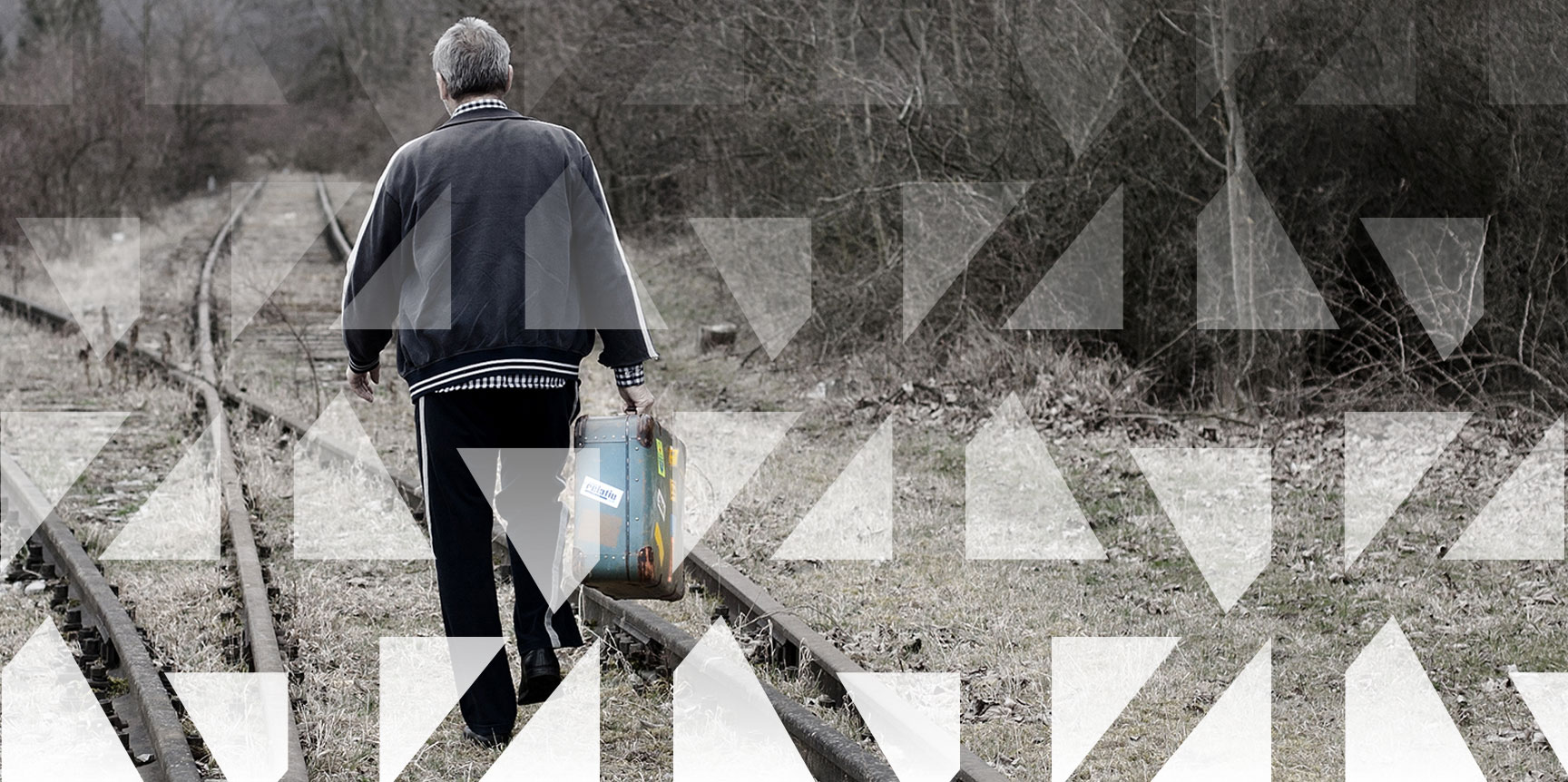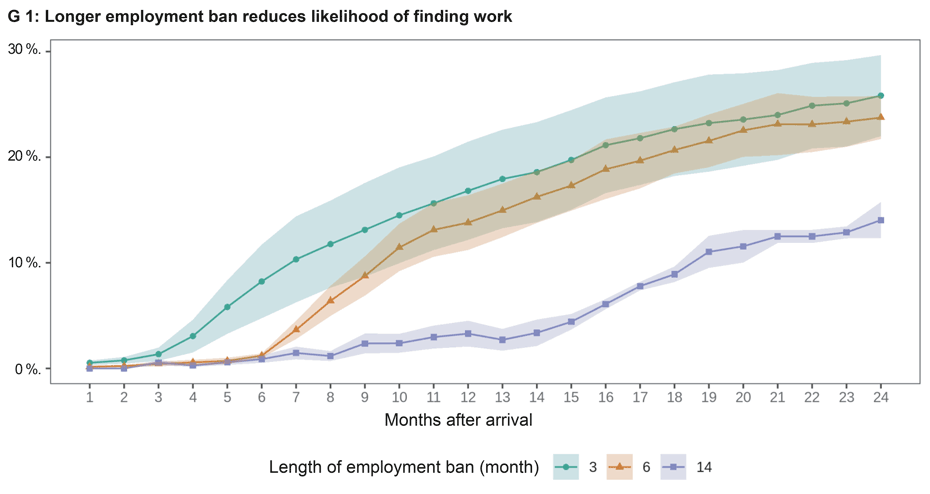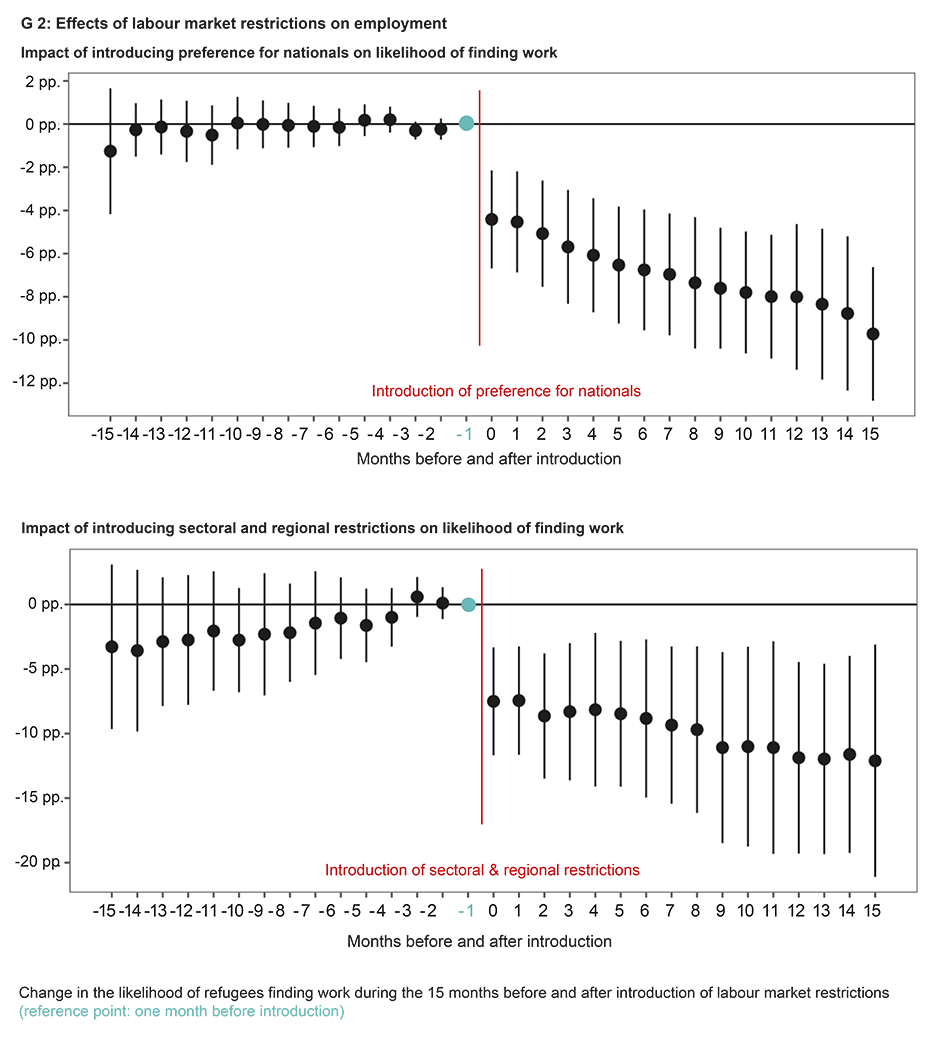
Labour market restrictions on refugees
Restricting employment opportunities for refugees reduces their likelihood of working and earning in the long term. This imposes high costs on refugees and host societies.
Refugees often have lower employment rates and wages than native workers. There are many reasons for these differences: different qualifications, preferences and discrimination can lead to refugees being less integrated into the labour market. Another factor that may contribute to differences in employment rates is policies that restrict migrants’ employment opportunities and exclude them – at least temporarily – from the labour market. Such labour market restrictions are widespread in European countries. They range from temporary employment bans after entry to work bans in certain sectors of the economy.
But what are the effects of these regulations? According to a new study by the Immigration Policy Lab and the KOF Swiss Economic Institute at ETH Zurich, the impact of the regulations can be severe for refugees and costly for the host society.
Various cantonal regulations
The effects of labour market restrictions are difficult to measure. This is because a variety of factors – from the personal characteristics of refugees to macroeconomic trends such as unemployment – can partly determine whether refugees integrate successfully into the labour market. In general, it is difficult to separate the effects of labour market restrictions from these other factors.
The research team at ETH Zurich has found a way of analysing the short- and long-term consequences of labour market restrictions. For this purpose, the team created a new dataset as part of elaborate research that shows how the Swiss cantons regulated the labour market integration of refugees during the period from 1999 to 2016. The dataset enables us to examine the effects of four widespread labour market restrictions using Switzerland as an example: (i) work bans for the initial period after arrival; (ii) the preference for nationals, which prioritises native workers in the labour market; (iii) sectoral restrictions, which limit labour market access to certain industries; and (iv) regional restrictions, which arise because refugees are not granted work permits in neighbouring cantons.
Switzerland is ideal for studying the impact of these restrictions for several reasons. Firstly, the high degree of federalism in Switzerland means that there are large variations in restrictions – both between cantons and over time. During the study period, for example, the time that refugees had to wait before they could take up a job varied between three and 14 months, depending on when the person concerned arrived and which canton they were assigned to. The chart below shows the level of integration into the labour market depending on the length of employment ban.
Secondly, asylum seekers in Switzerland are assigned to the various cantons almost at random, and most cannot simply move to another canton for five years or more. Dominik Hangartner, professor of policy analysis at ETH Zurich, explains: “If asylum seekers could choose which canton to move to, those with good potential in the labour market might opt for a canton with liberal practices. This would make it difficult to analyse the impact of labour market restrictions on the labour market integration of refugees.”
Negative effects on employment
Statistical analysis by the research team showed that all four labour market restrictions significantly reduce refugees’ income and employment during the first few years after entry. These results suggest that if a canton were to switch from the most restrictive cantonal regulations to the most liberal ones, employment opportunities for refugees would increase from 11 per cent to 19 per cent.
The research team also examined how quickly these negative effects of labour market restrictions occur. It showed that in the very month in which priority is given to nationals, or refugees are allowed to work in fewer cantons or sectors, there is a significant drop in both the employment rate and income (see Chart G 2). This negative impact becomes even greater over the course of the following months. These effects stem primarily from the fact that it becomes more difficult for refugees to find a job if they do not already have one.
Furthermore, it was shown that labour market restrictions continue to affect employment and income even when they no longer apply to the refugees in question. The negative impact of a preference for nationals and the ban on working on arrival persists for up to three years. Michael Siegenthaler, labour market economist at the KOF Swiss Economic Institute, comments: “This phenomenon is familiar from other contexts and is called the ‘scarring effect’. Poor labour market entry conditions can have long-lasting negative effects on individuals’ employment histories.”
Lower wages
Finally, the research team looked into the question of how these restrictions affect the hourly wages of those refugees who do find jobs. To do this, the team estimated how many potential jobs are lost by refugees because they are not allowed to work in certain sectors and neighbouring cantons. This estimate suggests that these two restrictions reduce the number of jobs available to certain refugees by almost two-thirds. The team was also able to show that hourly wages fall by over 2 per cent when the number of jobs available to refugees is 10 per cent lower owing to these restrictions.
But why do these restrictions reduce refugees’ earning potential? One possible explanation is that sectoral and regional restrictions impair refugees’ productivity. Sectoral restrictions could force refugees to work in sectors with low productivity and, correspondingly, low earnings. Or the restrictions could mean that refugees gain less work experience in Switzerland. However, the research team found little evidence that such productivity effects are responsible for lower wages owing to sectoral and regional restrictions. Siegenthaler adds: “The restrictions appear to undermine the principle of equal pay for equal work.”
The authors provide evidence that this is because there are fewer ‘outside options’ available in restrictive cantons – i.e. a lower number of alternative employment opportunities. Because sectoral and regional restrictions reduce the number of jobs that refugees can potentially take, they weaken refugees’ bargaining position in wage negotiations and make them dependent on individual employers.
They are also less likely to find a job that is comparatively well paid. The inferior outside options are reflected in the data – for example, in the fact that refugees change jobs less often because of the restrictions placed on them. Refugees in more restrictive cantons also react less to wage reductions than in cantons with fewer restrictions. Andreas Beerli, labour market economist at KOF, comments: “Our results suggest that individual wages depend significantly on how many jobs one is eligible for in the labour market. Although this seems obvious, it has been difficult to prove until now. This is because outside options typically cannot be observed in labour market data. Moreover, individual changes in outside options are not usually random.”
Costs and benefits of restrictions
Overall, the findings suggest that labour market restrictions are a major reason why refugees have lower employment rates and wages than comparable native workers. Why are they nevertheless so widespread?
One motive for imposing restrictions could be to protect the jobs of other groups that are likely to compete with refugees for jobs. According to the ETH study, however, there is little evidence that these restrictions improve the labour market prospects of other vulnerable groups of workers. For example, the restrictions have no measurable impact on the monthly incomes of migrants from low-income EU-15 countries who live in the same canton.
Another reason commonly cited by policymakers to justify restrictions is to encourage refugees – especially those who have entered the country temporarily – to emigrate. However, one look at the data reveals that refugees are no more likely to emigrate because of the restrictions. Achim Ahrens, senior data scientist at the Immigration Policy Lab, concludes: “Restrictions can be very costly for host societies, as refugees have to be supported with welfare benefits”.
The results suggest that such restrictions are difficult to justify economically. While restrictions on labour market access impose high costs on refugees, they offer few benefits for other migrants and the host society. Switzerland and many other countries that impose similar labour market restrictions are therefore likely to pay a high price.
A working paper entitled ‘The Labor Market Effects of Restricting Refugees’ Employment Opportunities’ is available here: https://www.research-collection.ethz.ch/handle/20.500.11850/595935
Contacts
KOF FB KOF Lab
Leonhardstrasse 21
8092
Zürich
Switzerland
KOF Konjunkturforschungsstelle
Leonhardstrasse 21
8092
Zürich
Switzerland


